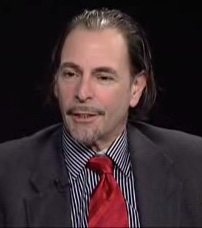Dr. Alan H. Goldstein
The Salon.com article I, Nanobot by Alan H. Goldstein said
“Scientists are on the verge of breaking the carbon barrier — creating artificial life and changing forever what it means to be human. And we’re not ready…I can tell you the exact moment when Homo sapiens will cease to exist. And I can tell you how the end will come. I can show you the exact design of the device that will bring us down. I can reveal the blueprint, provide the precise technical specifications. Long before we can melt the polar ice caps, or denude the rain forests, or colonize the moon, we will be gone. And we will not — definitely will not — end with a bang or a whimper. The human race will go to its extinction in a state of supreme exaltation, like an actor climbing the stairs to accept an Academy Award. We will exit the stage of existence thinking we are going to a spectacular party.”
Dr. Alan H. Goldstein is Professor of Biomaterials, Fierer Chair of Molecular Cell Biology, and Biomedical Materials Engineering and Science Program Chair at Alfred University. He earned a B.Sc. in Agronomy at New Mexico State University and a Ph.D. in Genetics at University of Arizona.
Alan began his career in the 1970s as a molecular biologist before becoming a theoretician in the field of nanobiotechnology. He has codified the central concepts of this nascent area of knowledge into a set of operational rules termed the Laws of Biomimetics. As part of this work, he has published a set of guidelines specifically designed to identify the artificial life forms likely to emerge from research at the intersection of nanotechnology and biotechnology. He has also created the “Animat Test” as a practical bioengineering tool for monitoring the coming transformation from natural to artificial biology.
His essay Nature vs. Nanoengineering: Rebuilding our world one atom at a time won a 2003 Shell-Economist Prize and remains the primary reference in the nascent field of nanobioethics. He was the first person to use the term “Breaking The Carbon Barrier” to identify the future moment when humanity successfully engineers the first nonbiological life form. This concept was formally introduced and defined during a debate with Ron Bailey at the Foresight ‘Vision Weekend’ component of the 13th Foresight Conference on Advanced Nanotechnology.
Alan’s popular science publications include The (really scary) soldier of the future: Thanks to nanotechnology, he’ll be a lethal superman who can heal himself., Everything you always wanted to know about nanotechnology… But were too afraid of quantum spookiness to ask., Nanomedicine’s brave new world In just a few years, doctors will know everyone’s genetic identity. This knowledge will be a blessing — and a curse., and Invasion of the high-tech body snatchers: Ready for infrared vision, and hearts that work better than the original? While bioethicists obsess over cloning, bioengineers will soon be able to replace every part of our bodies.
His hard science publications include Cloning of a mineral phosphate-solubilizing gene from Pseudomonas cepacia in Applied and Environmental Microbiology, Mining by Microbe: Separating Phosphate From Ores Via Bioprocessing in Nature Biotechnology, Cloning of an Erwinia herbicola gene necessary for gluconic acid production and enhanced mineral phosphate solubilization in Escherichia coli HB101: nucleotide sequence and probable involvement in biosynthesis of the coenzyme pyrroloquinoline quinone in Journal of Bacteriology, and Evidence for Multualism Between a Plant Growing in Phosphate-Limited Desert Environment and a Mineral Phosphate Solubilizing (MPS) Rhizobacterium in FEMS Microbiology Ecology.
Alan is a member of the American Association for the Advancement of Science, Society for Biomaterials, and the American Society for Microbiology.
